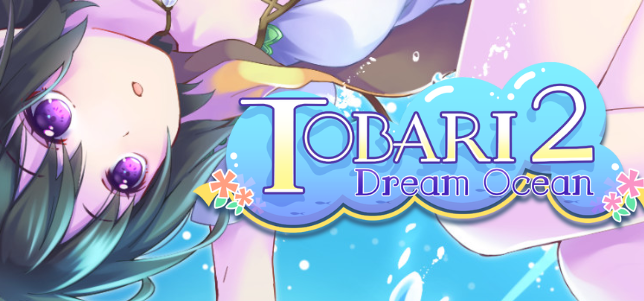A blend of classic platformers, Tobari 2 serves up saltiness with a pleasant aftertaste.
Type: Single-player
Genre: Platformer, Action
Developer: Desunoya
Publisher: Sekai Project
Release date: 17 July, 2020


Intro
Pixel art retro platformers a pretty well-populated genre on Steam. Pixel art is a lot easier for a dev on a budget with limited artistic talent, and you can rely upon a combination of nostalgia and the fact that the games you’re emulating became classics for good reason to help sell your spiritual successors to your favorite games as a kid.
Desunoya, possibly because the pixel art retro style isn’t a thing in Japan, goes the harder route of making a game that isn’t pixelated at a native resolution of 720p (Japan seems to oddly lag behind on resolutions), while still doing basically the same thing of remaking the classics of yesteryear.
It’s like…
There are occasionally some people I’ve seen online that get angry when people describe games by comparing them to other games. I am going to make them furious right now, because the best way to understand Tobari is to realize that it’s basically just cribbing notes from classics of the genre.
Tobari is a magic girl whose only innate power is the ability to give enemies a goomba stomp and to swing her magic key-staff. Hitting specific types of enemies with the staff swing will make a spell pop out that Tobari can then collect and use, herself. (Protip: Tobari can hit enemies with her backswing. Normally, hitting enemies with the staff sends the magic to the other side of the enemy, making Tobari have to jump over the enemy to try to grab it, where it might even be thrown off a cliff so you can’t get it. Turning your back to an enemy before hitting them flings the spell towards Tobari, however.) Because many enemies can damage Tobari if she jumps on them, or are just too densely packed or spitting fireballs for Tobari to get close, and the staff is both short range and immobilizes Tobari for a solid second while she swings, getting the right kind of spells is key to success.
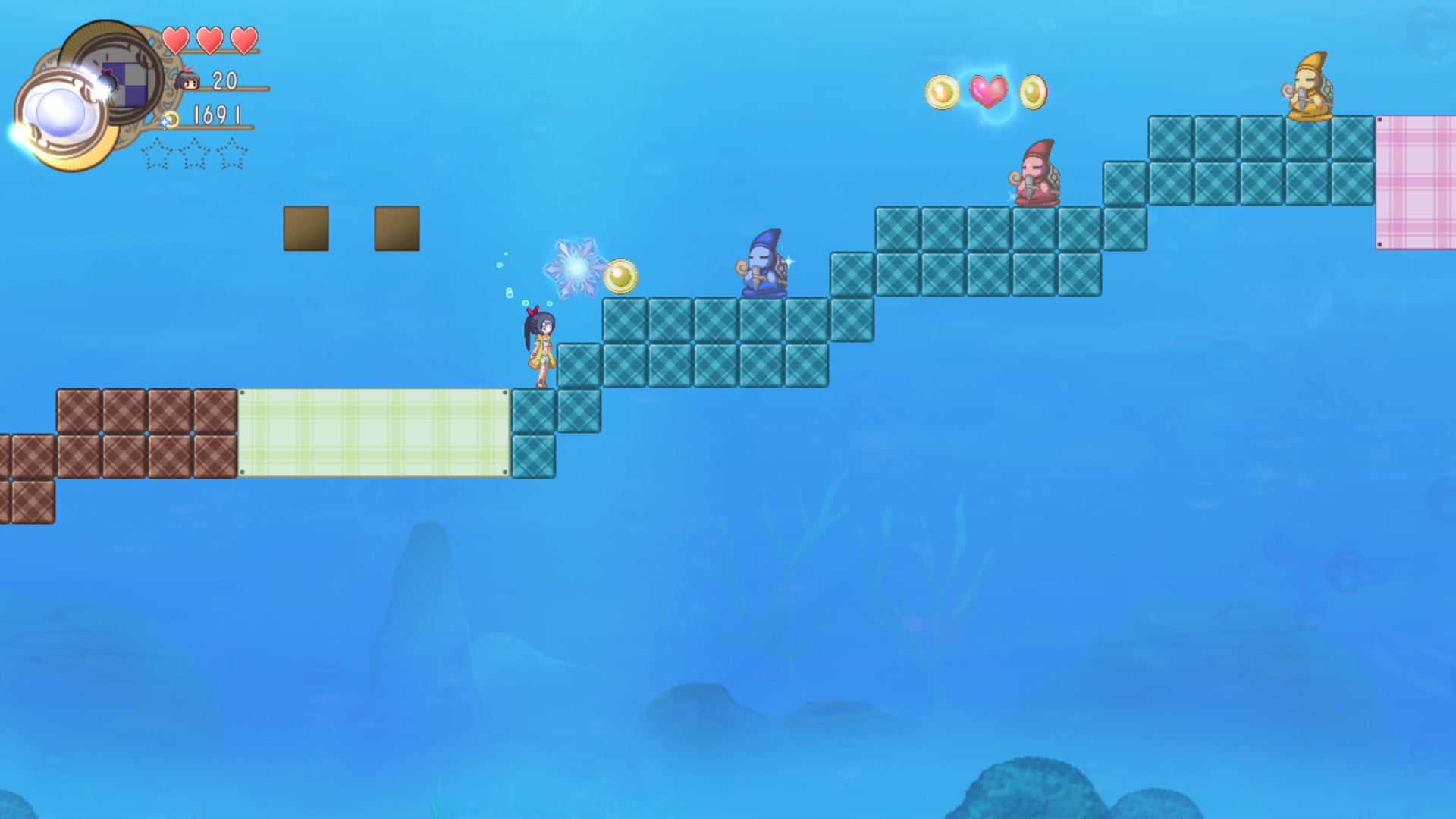
In this regard, Tobari is most like Kirby, specifically the earlier/simpler Kirby games where there weren’t context-based powers, and each power just had one and only one effect. Fire, for example, only shoots fireballs directly horizontally. (Plus they’re nearly useless underwater, as they fizzle out.) Unlike Kirby, however, Tobari can carry two spells at a time, and swap between them freely. (If Tobari has two of the same power, they often have a powerup. Double fire spells lets Tobari shoot two fireballs that are fired diagonally.) She also doesn’t drop powers if she takes heavy damage, which is a good thing considering much of the game is built based upon demanding you use a particular power for a given stretch of a stage, and not having it means needing to retry to go back to the last checkpoint.
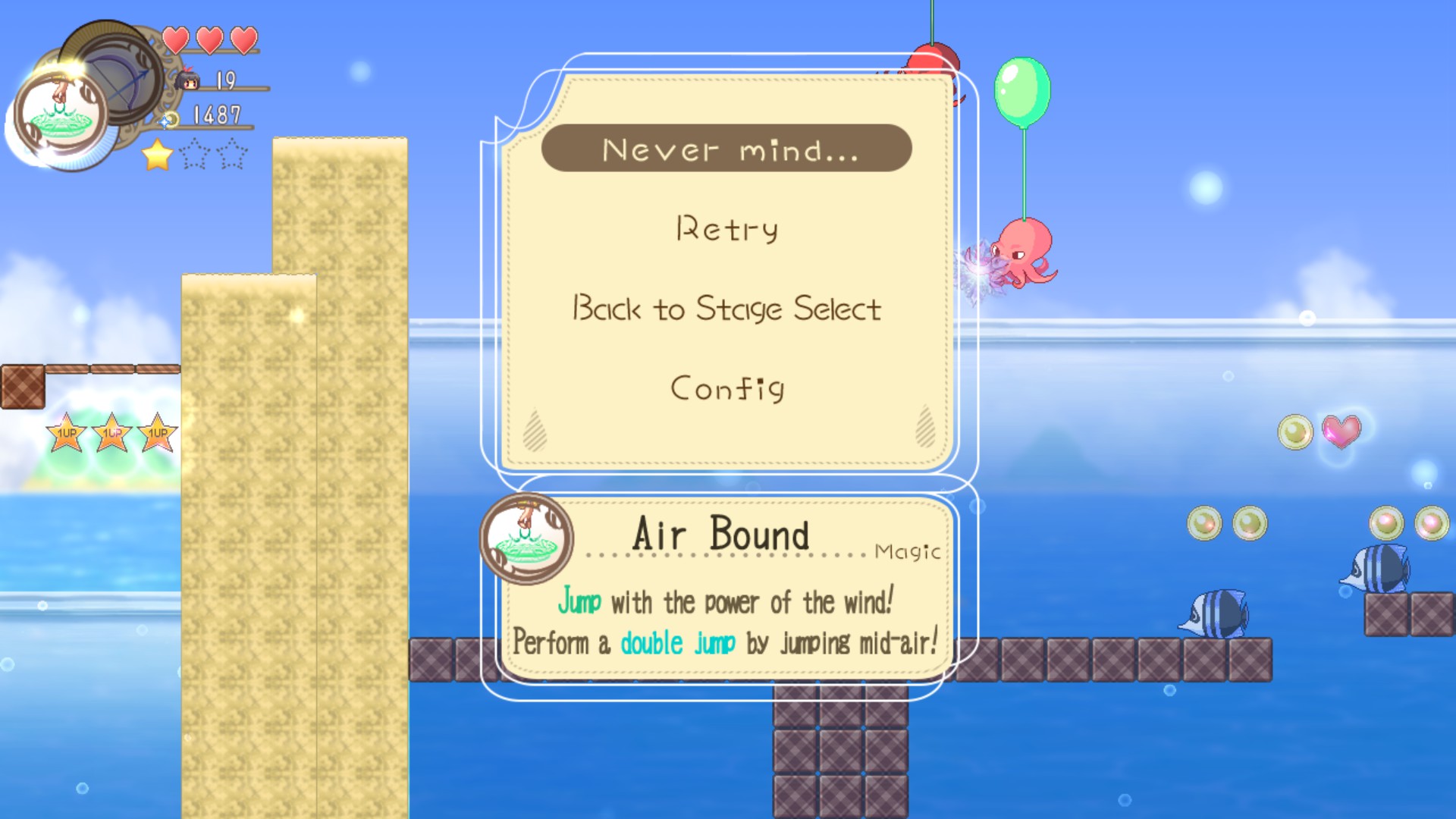
Another major issue is that, unlike Kirby, many spells are mobility or utility magic only. Spells like Hover lets Tobari skim the surface of the water, while Wind lets her jump higher and float down more slowly, and spells like Speed Up, Slow, and Stop all manipulate time, but none of these actually allow Tobari to attack any enemies.
Beyond the Kirby-like elements, however, the way that the game’s stages are actually designed is straight out of Mario, particularly the New Super Mario Bros 2D games. The game is filled with all your least favorite Mario levels, like ones where the screen constantly moves and you have to keep up or die, or the ones where you need to keep up with a moving platform that is your only way to get across bottomless chasms. Each stage has three star fragments for you to collect that are hidden in locations designed to challenge your ability to explore or perform precision high-speed maneuvers. Every stage has a goal that seems ripped straight from Super Mario World. (Fortunately, unlike Mario, you can’t get killed walking off a cliff when you pass the goal.) Many stages also have a secret secondary goal that lets you go to different stages.
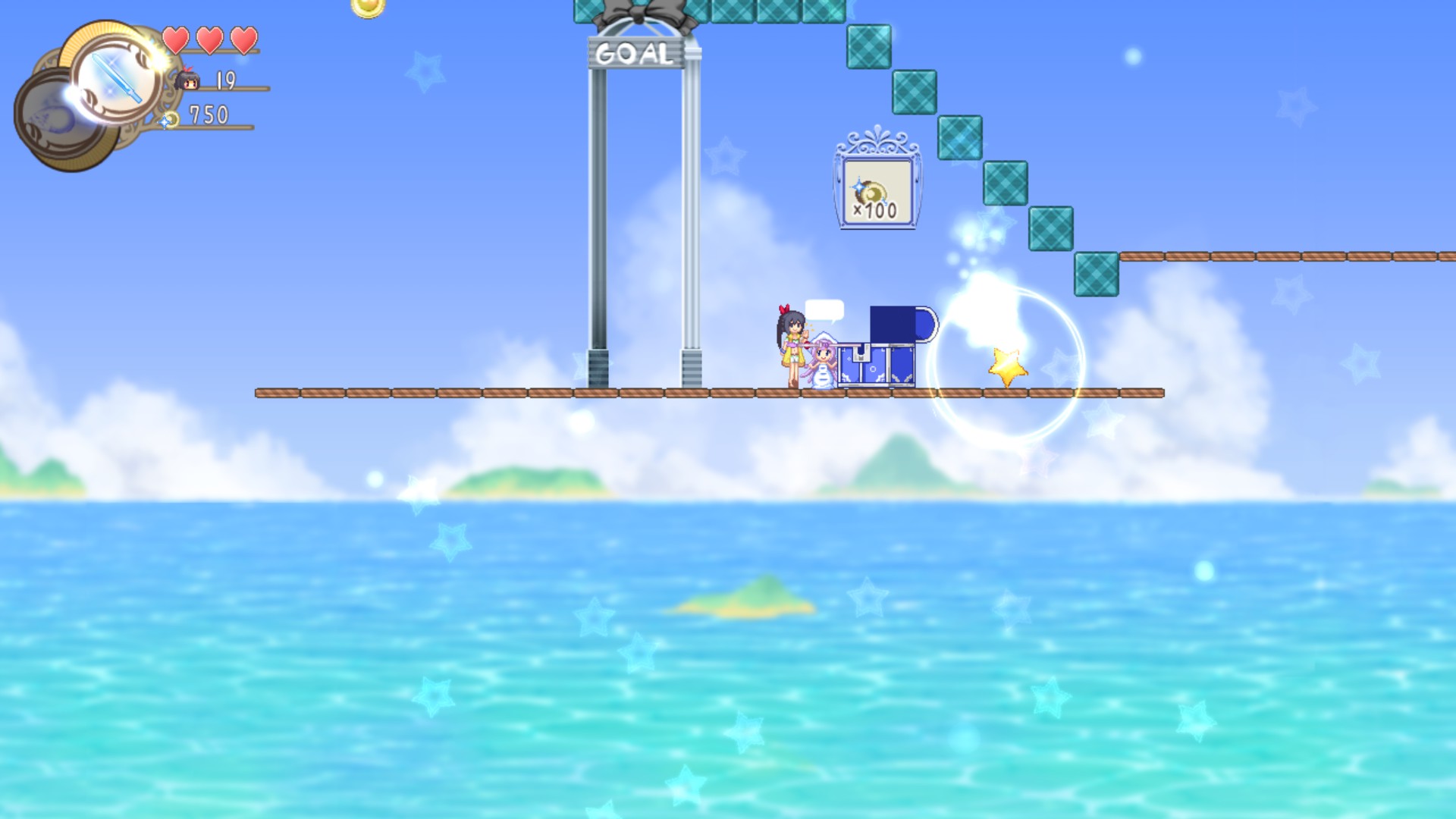
In fact, Tobari is so much like Mario, it features inexplicably floating yellow boxes you can jump into to get coins or hearts that will slowly move away from you like a mushroom.
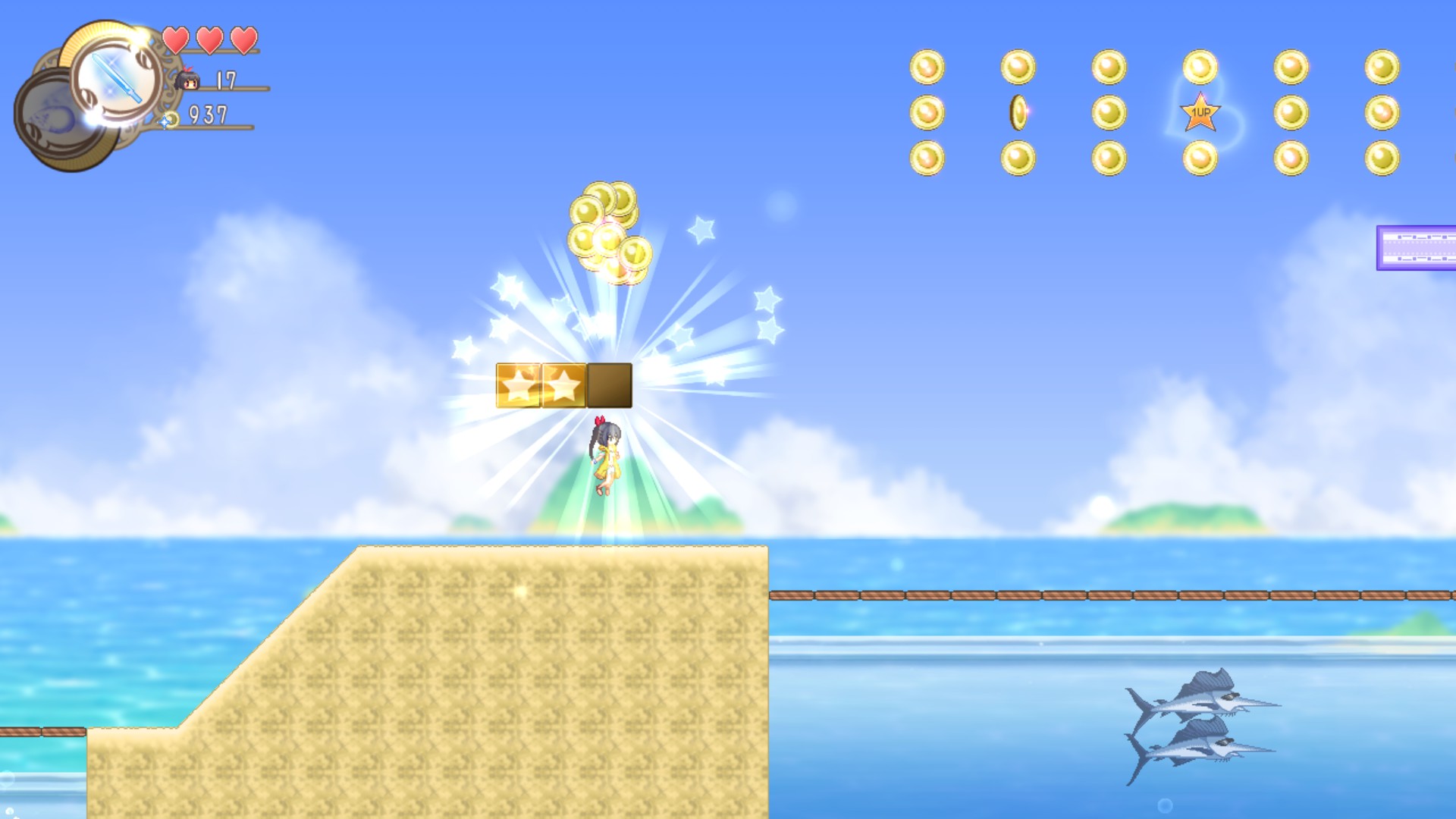
Unlike Mario, however, coins aren’t just useless score. Instead, the game is littered with shops that allow you to buy powerups. There tend to be some before bosses, and you can buy up to three “jellied yams” (eww) that give you extra heart containers until you die or clear a stage. You can choose from a small selection of attack spells or even buy a checkpoint so you restart near the boss. It’s a much more meaningful system than the relatively vestigial coins in Mario.
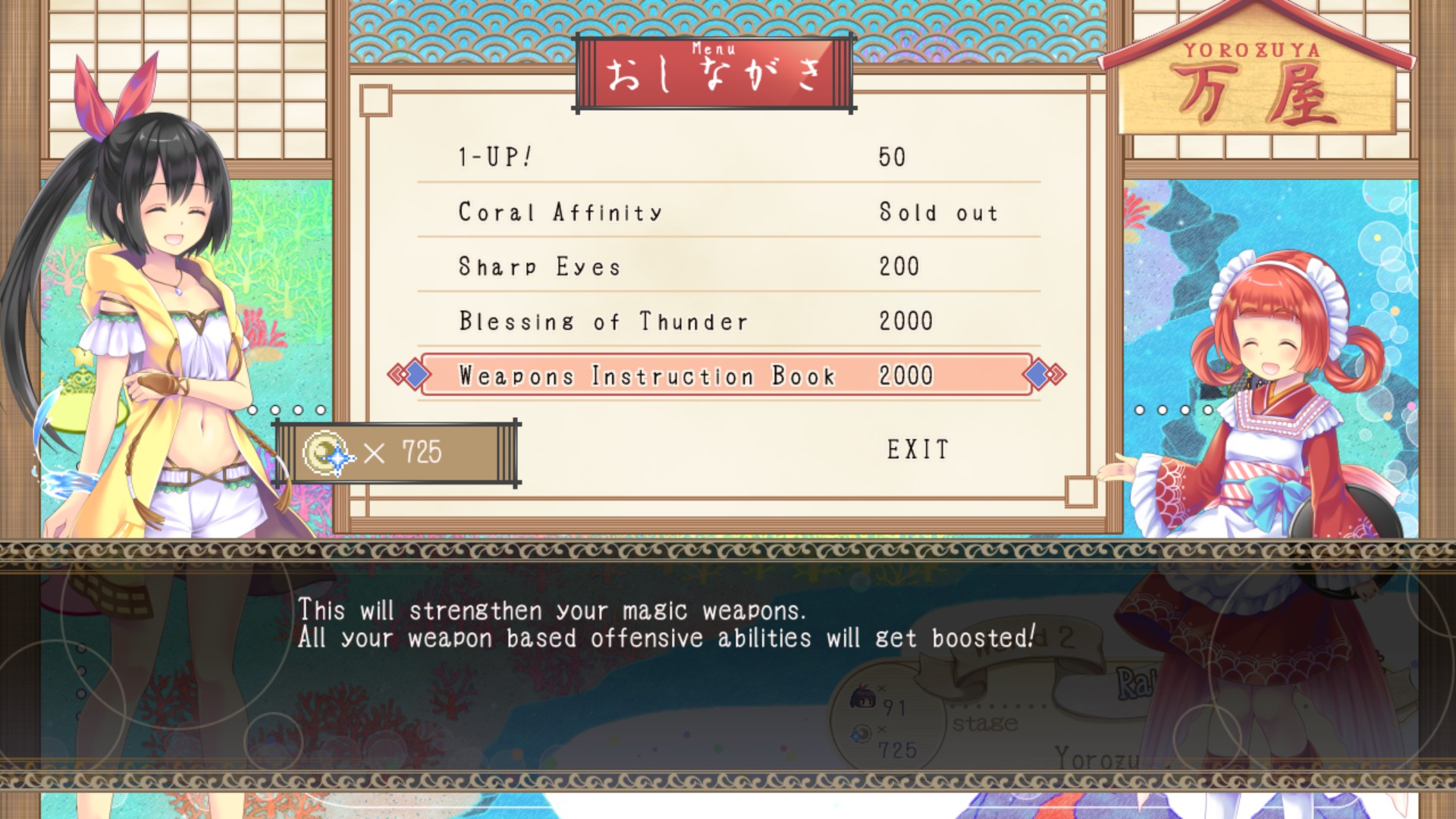
While keeping it to just these classic platformers would be enough, Tobari also features boss fights that are a strange blend of Megaman bosses and playing a bullet hell game like those in the Touhou franchise.
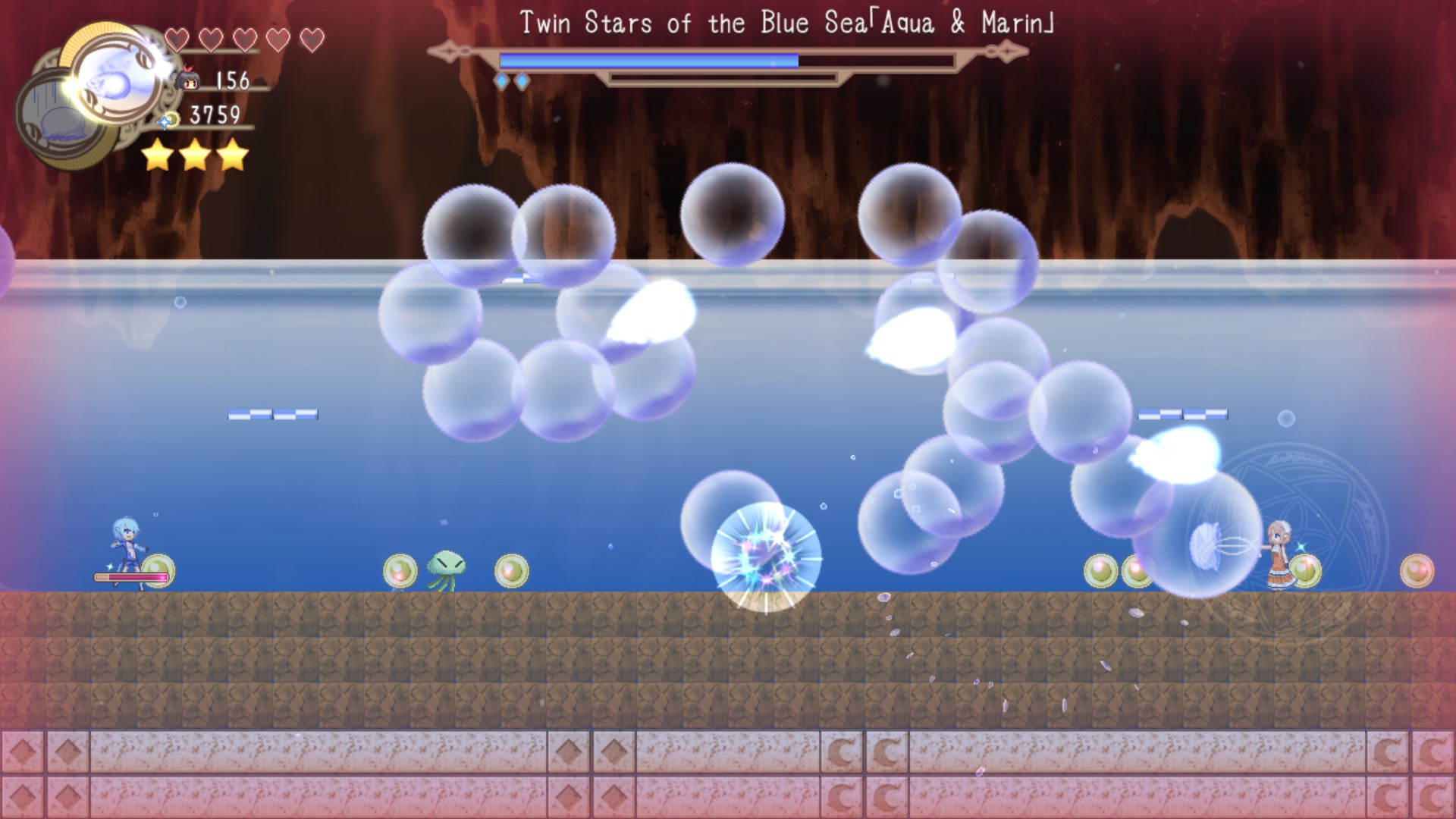
Something else that particularly reminds me of Touhou is the fact that all the humanoid characters in the game are girls who all have to fight Tobari before they wind up becoming friends upon defeat. (In fact, before making Tobari, Desunoya was making Touhou fangames, and the first Tobari was originally translated by the team that translates Touhou games.)
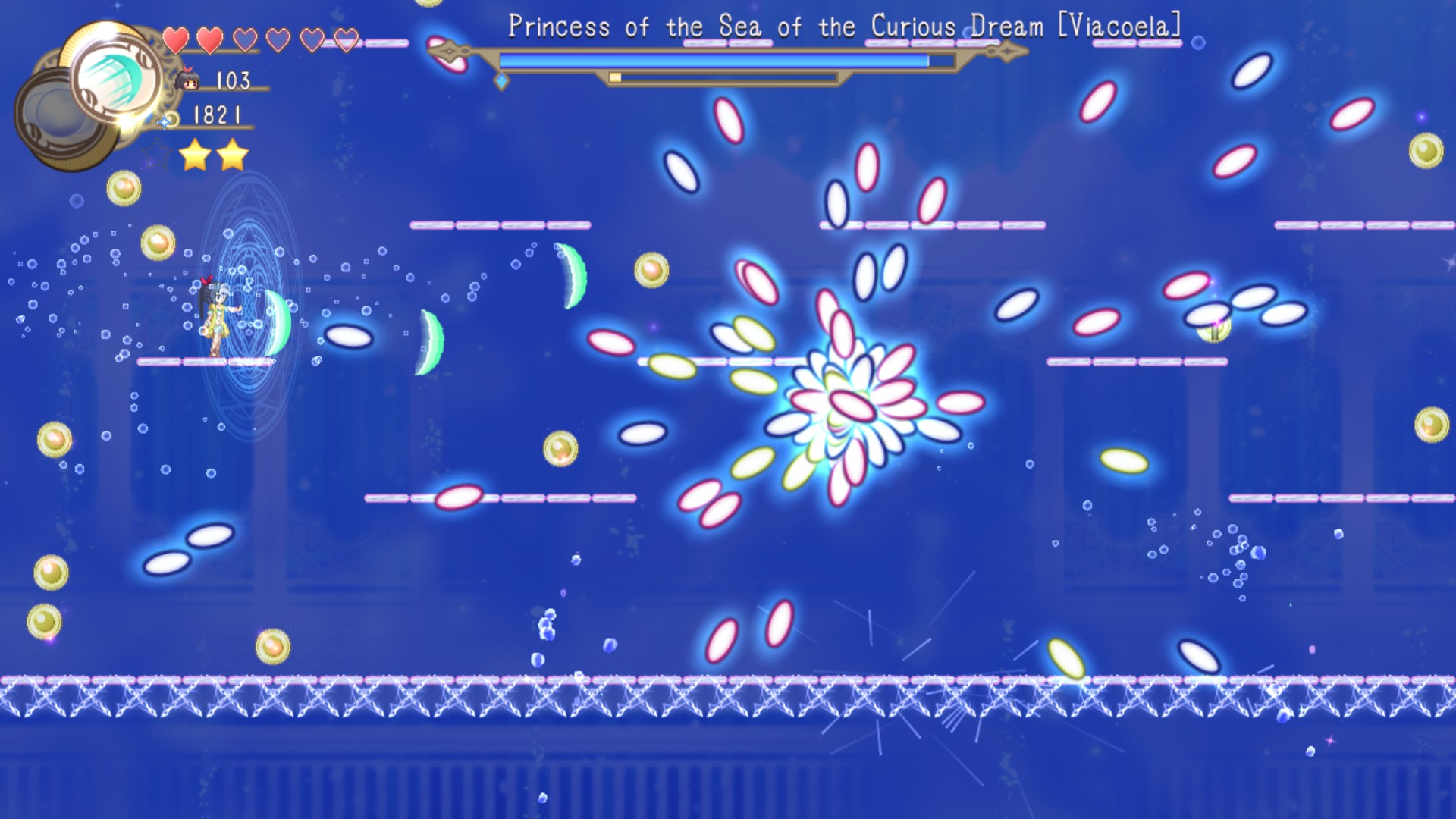
Story
… Well, this would normally be where I rehash the events that lead up to Tobari’s adventure. The problem is, the game doesn’t really have one. You basically have to piece together what must have happened from dialogue that plays mid-game to get you to where you are. It feels like this was something that was printed on the first page of a manual that never was translated or shipped in the English download-only release.
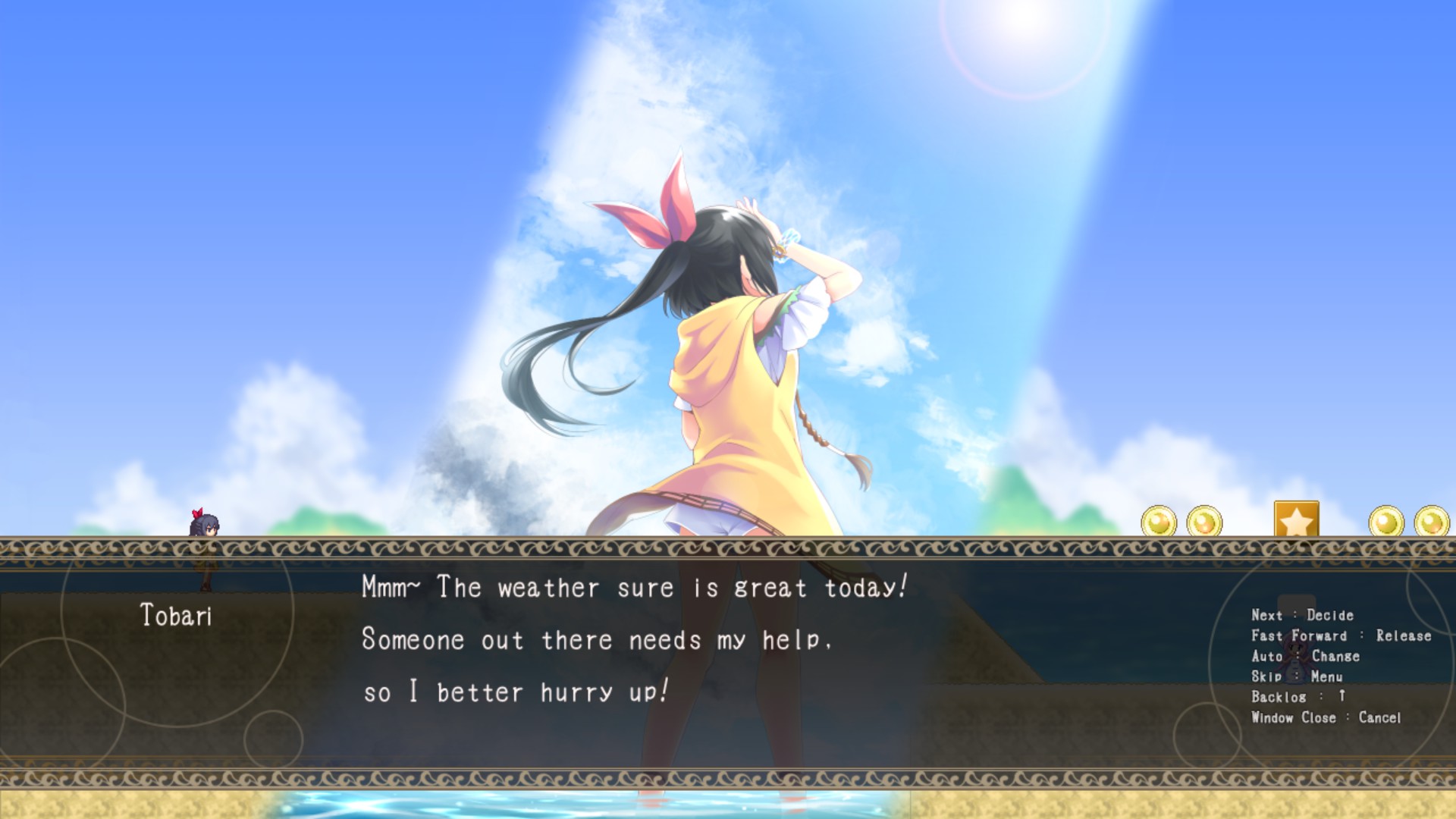
Apparently, a friend of Tobari’s, named Hina, gets mysterious dreams that get Tobari to go to the ocean to try to rescue someone held captive under the sea. Hence, all the girls Tobari “forcibly befriended” in the last game put on swimsuits and go on a beach vacation, although you only see them as pop-ups on the bottom of the screen during gameplay and the closing credits. Tobari also at some point gets a water bracelet that lets her breathe underwater and move around in it like it’s slightly thicker air. She doesn’t know it does this until you’re forced underwater in the second stage, however, because that’s another cutscene.
The game isn’t particularly concerned with setting any dramatic stakes, either. The final boss wants to invade the surface because she streamed some movies about that topic off the Internet, and the extra world boss, “Nightmare Tobari”, is Bizarro Tobari and outright laments the fact that the reason she lost is because the player is more skilled than her script.
Tobari as a franchise actually suffers from this problem of not having the plot explained. Trying to Google it, I read from a single review that Tobari as a franchise started as a fan fiction for some obscure PS2 visual novel porn game about screwing pet catgirls whose serial numbers were filed off to make it legal to sell as its own thing. Sadly (or perhaps fortunately), I have no idea how any of that relates to Tobari essentially being Kirby Potter and the Mermaid’s Platformer. That said, I couldn’t find any other source for this information, so perhaps it’s wrong, and there’s simply no stated reason what the heck is going on with this world and why schoolgirls use magic to conquer the moon around here.
LOOK, the important thing is, there’s collectables to collect, stages to clear, and bosses to defeat, so are you going to video game in this video game, or not?!
Spell Selection
The game’s store page advertises having over thirty different spells Tobari can collect, but you’ll be seeing the same eight or so powers throughout most of the game, and you’ll see some powers appearing in only two of the 54 normal stages. Unlike Mario, you can’t carry over powers between stages, so you’re forced to use the powers they’ll let you collect in a given stage. (Some movement powers like Swimming would trivialize most underwater stages.) Many stages are essentially built upon forcing you to use one particular power (they often have a spell dispenser or an enemy you can take the spell from who infinitely respawns so you can always get the spell back if you drop it for some reason), so you’ll have several stages that explicitly require using the Beach Ball spell that breaks certain blocks to get through, or the Hover spell to skim over the water and not die in the bottomless pits, or the Wind spell to slow your descent while you try to bounce on trampolines past corridors of spikes.
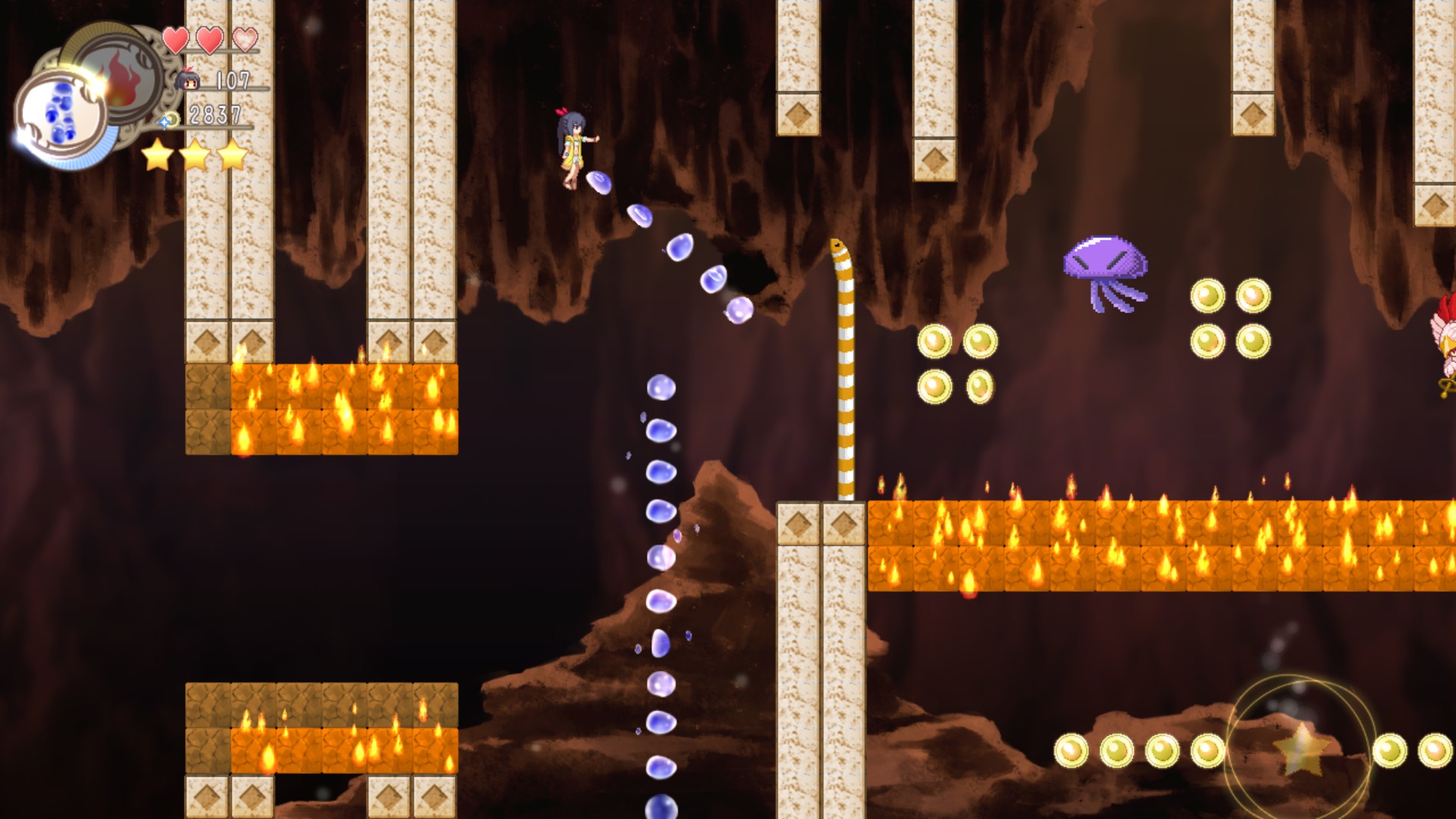
Generally speaking, when it comes to attack spells, you’ll tend to get a choice of three or more, but when it comes to the mobility skills or time-manipulating skills, they’re vastly more restricted. That said, many attack spells behave differently in the water. Ice just deals damage but can turn an enemy into an ice block when it kills the enemy above water. Underwater, it only makes ice blocks and doesn’t hurt enemies at all, becoming useless as an attack.
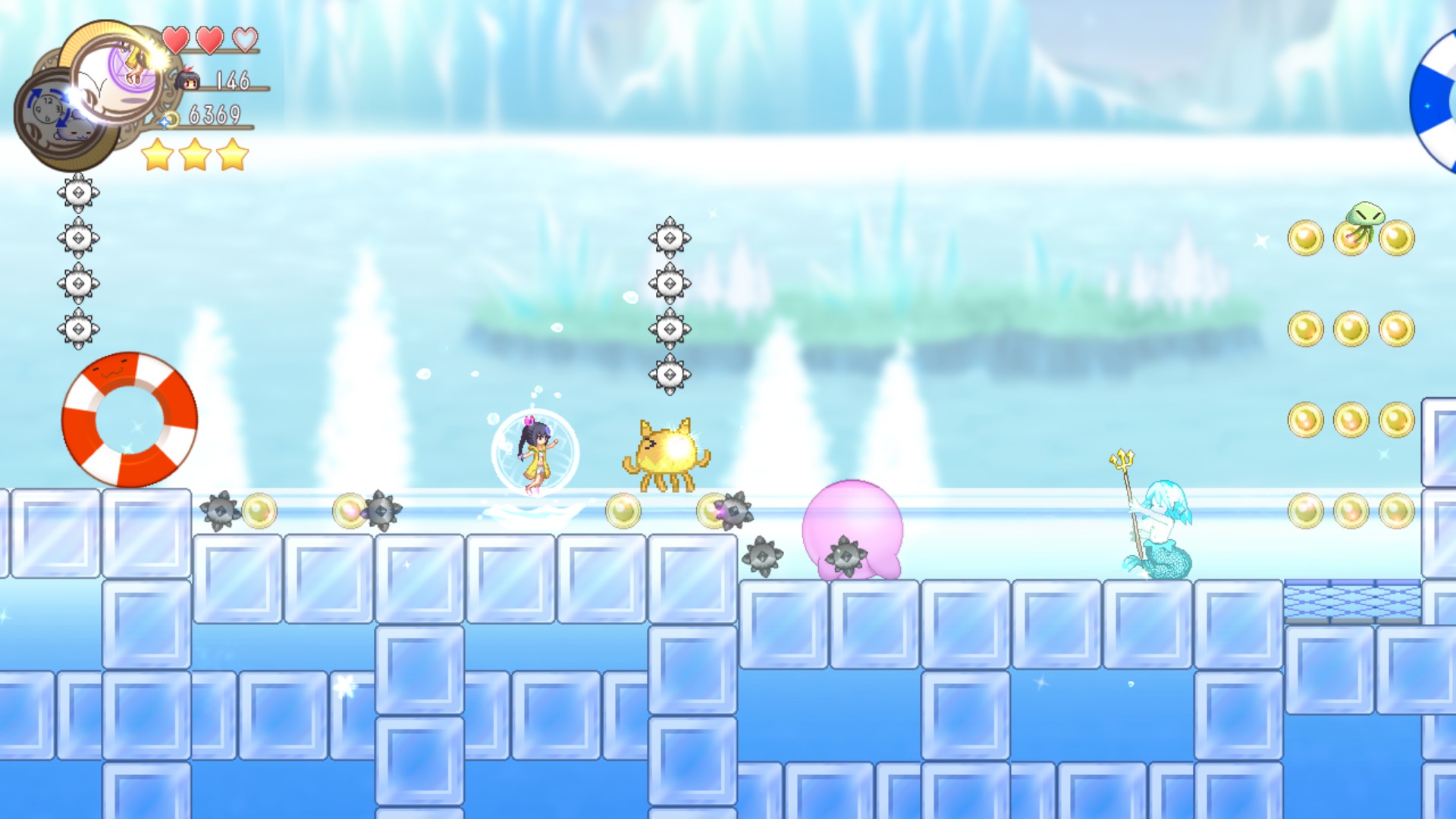
What makes this really interesting is that Mario generally has you using the same abilities throughout the whole game, with only a few extra gimmick terrains or moving platform stages or the like to try to test you in new ways. Kirby would occasionally have stages that force a particular power, like fire to light cannon fuses, but for the most part let you pick your own preferred powers, and was generally not difficult enough to really test your skill mastery to the limits. Tobari, meanwhile, is quite happy to add new spells to a given stage, thus forcing you to adapt the new ways that Tobari can move or act, and then demand you master that spell. Considering that the developer can just keep adding new spells that are more double-edged swords than the last, it can keep extending the repertoire of skill mastery it demands of players in novel ways out far past when a Mario level designer would have to keep throwing the same tricks at you.
Difficulty Curve
Keeping up the Mario tradition, the game is segmented into “worlds”. YouTuber Ben “Yahtzee” Kroshaw has made a joke song about the order the eight worlds of a Mario game go in, and the seven worlds of Tobari 2 goes, “Beach world”, “Underwater World”, “Fire World”, “Anti-gravity World”, “Ice World”, “Boss”, and “Bonus World of Hell”.
The game features an option called “Enjoy Mode” that makes it so you don’t die if you fall into bottomless pits and possibly makes the game easier in other ways. (I didn’t actually try it.) The first world also starts out easier than most Mario game first worlds start out, oddly enough. You can easily get through the first world besides the one hidden bonus stage without dying, and most of the stages without even taking damage on your first run.
The difficulty does not stay that forgiving.
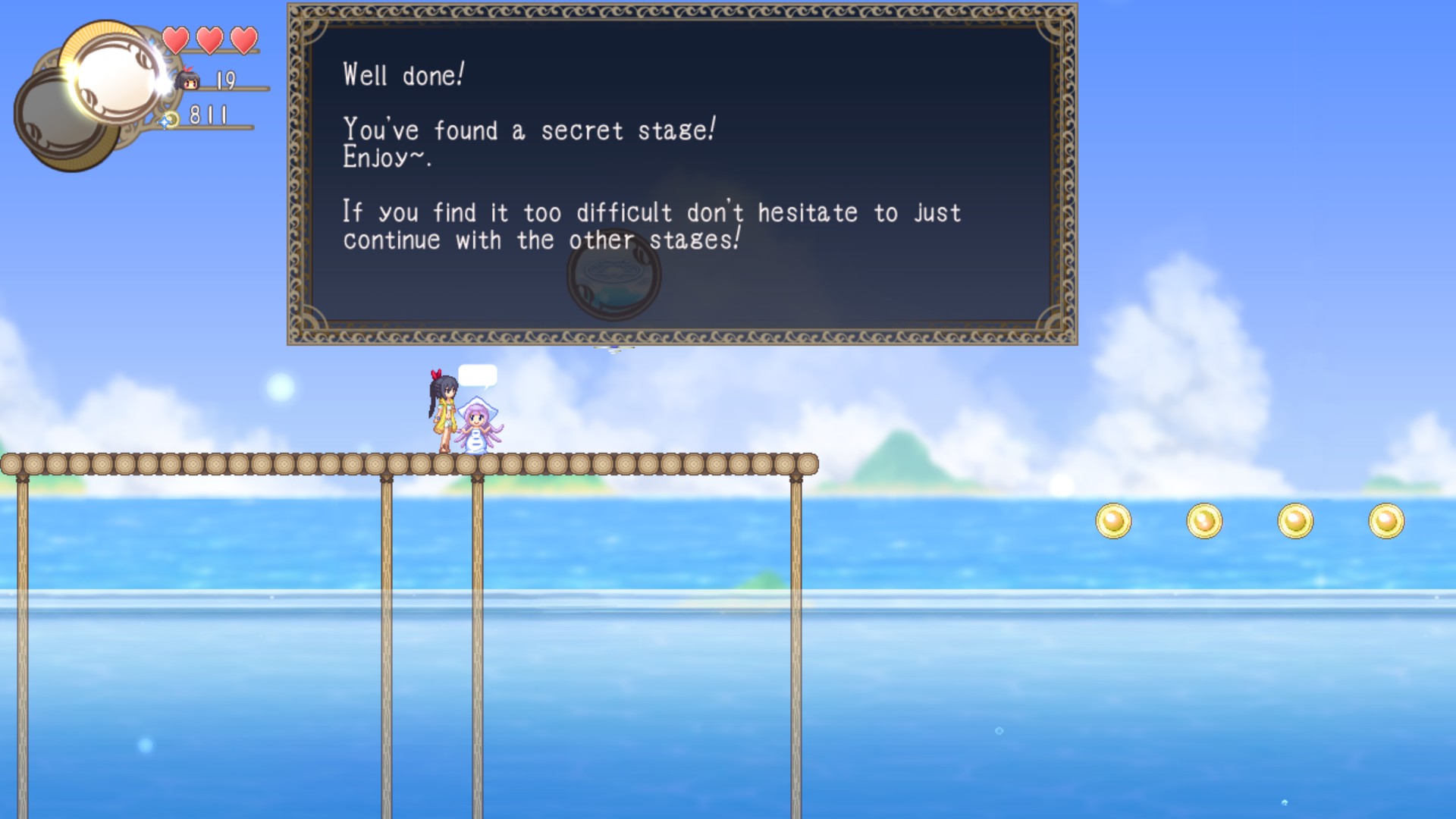
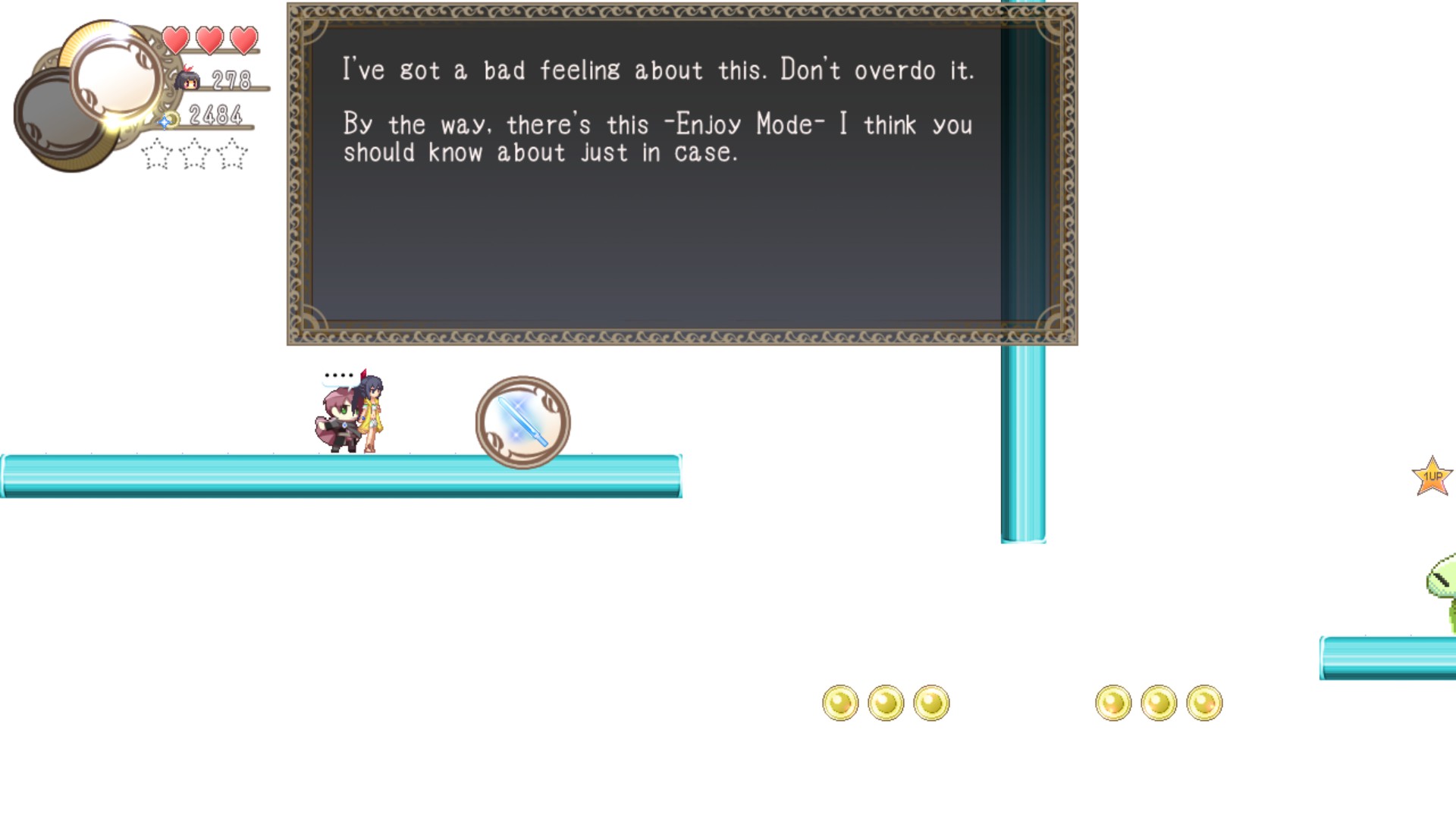
Rather, for a game that seems to take inspiration from Touhou and belongs in the doujin game world where only veteran enthusiasts of a genre will be likely to pick a game up, it’s actually a real oddity that the game actually has training wheels this forgiving in the first place, although it eventually gets quite hard. From starting out as easier than a Mario world 1, the game rapidly reaches into Mario bonus world difficulties by the end of the normal game. It gets into borderline Kaizo Mario/Mario Maker troll stage levels of difficulty by the bonus stages.
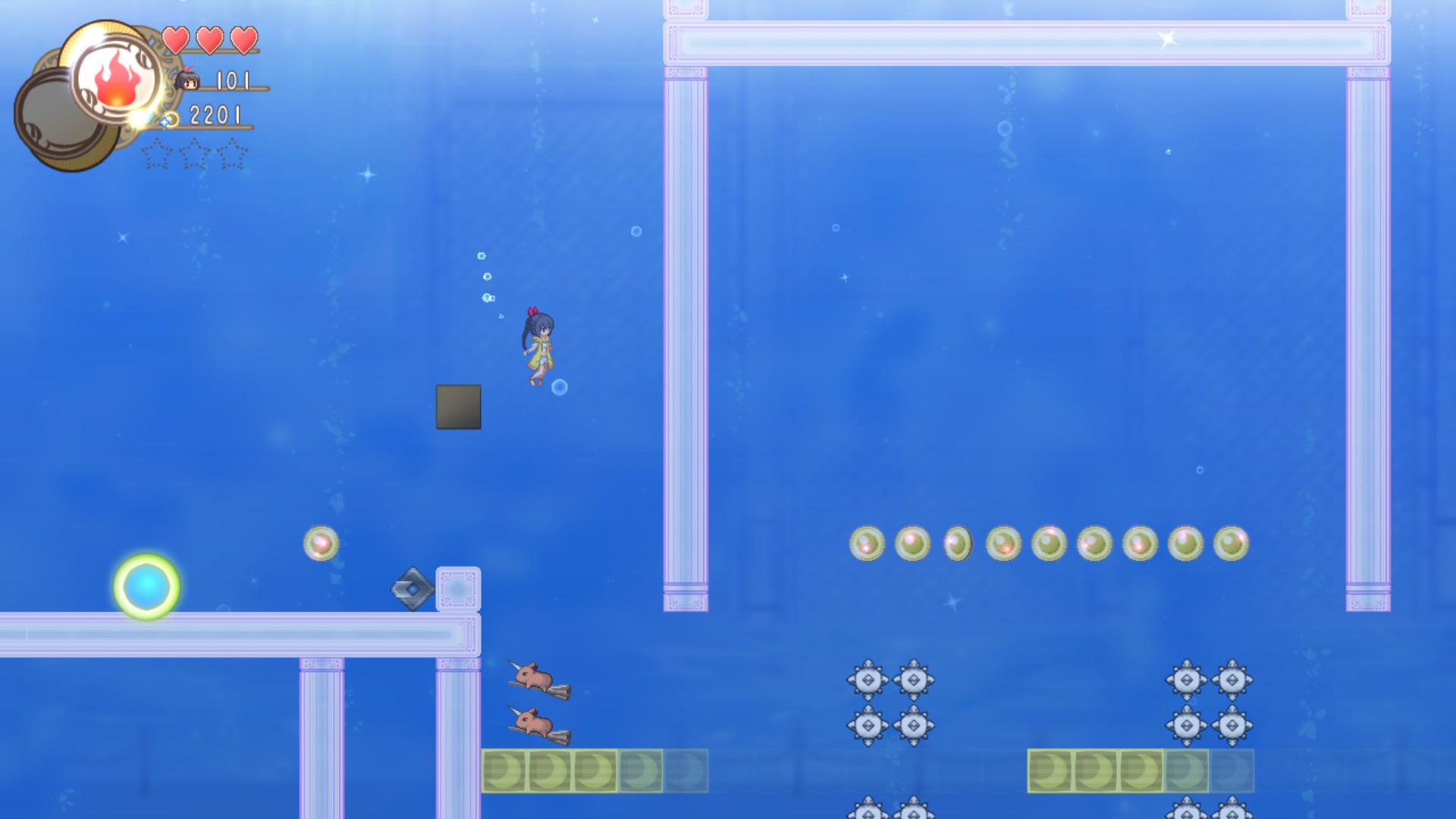
A lot of the game becomes a matter of trial-and-error gameplay, where certain obstacles require strategies or spells you wouldn’t be able to guess without having scouted the map out ahead of time.
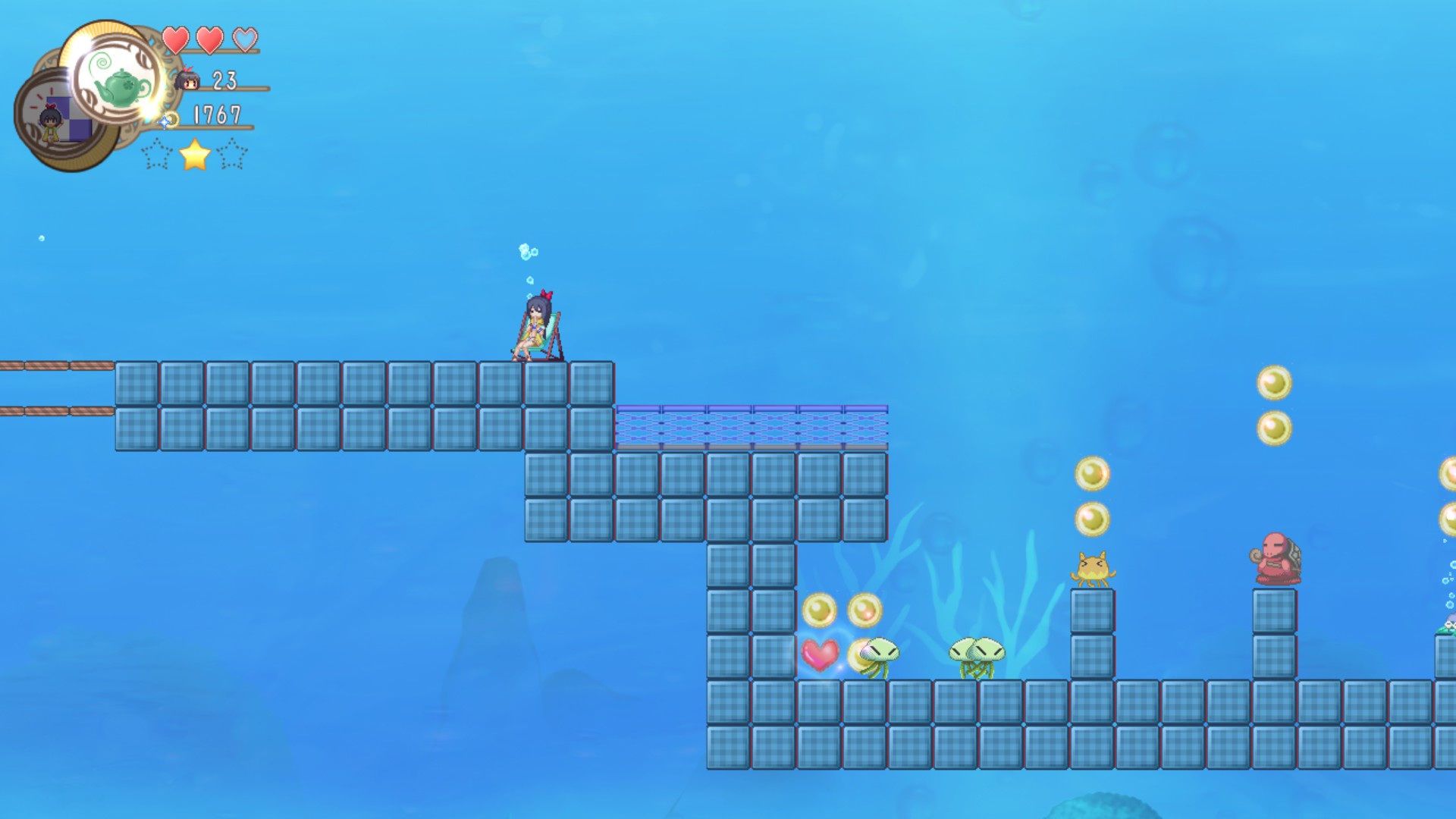
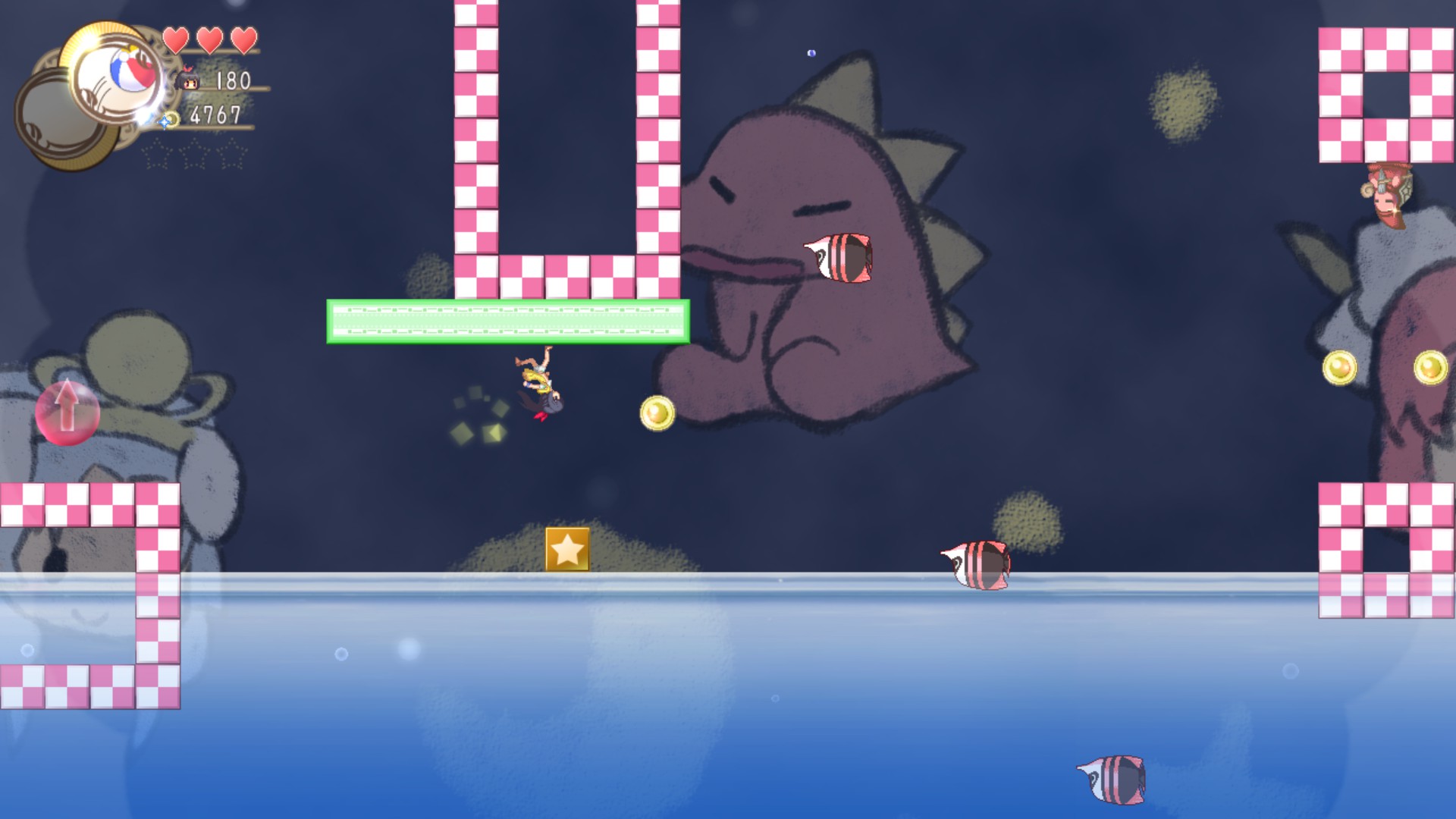
Cheevos and Speedruns
What, you think just surviving to the end of the game and beating the final boss, collecting all the stars, then going on to beat all the absolutely insane bonus stages was enough? Not a chance, sucker! Now beat all the bosses without taking damage for achievements! (This is including the absurdly tough final boss with a million hit points that the game only vaguely hints to you will drop a special super weapon in her third phase when you staff-whack her during the dialogue you’re almost certainly ignoring because you’re dodging boss bullets. Without it, it seriously takes about 20 minutes to chip damage the final boss to death if you manage to survive. I died 30 times and spent the better part of a day on that boss fight before I figured that out. It’s not just ocean water that’s salty around here.)
Oh, you think just defeating all the bosses without taking damage is special? Now play the game over again and 100% speedrun it in less than three hours for another achievement, and do it while losing 10 lives or less for another. Now replay the game without ever buying anything in the shops (which include selling spells or hearts before bosses)!
Considering as this is a game you can probably 100% in 20 hours or less, it’s nice that they set goals to give you reasons to replay the game. Speedrunners will also enjoy having the clock and death counter be tracked by the game itself, as well. That said, there is no way I’m subjecting myself to this after those last bonus stages.
Do You Want to Have a Nightmare?
While not part of this game itself, in Japan, Tobari 2 came out with a special bonus mode, Nightmare Mode. This puts the game into full-on Kaizo Mario/Mario Maker troll levels of difficulty from the start. If you’re the sort of masochist that cannot get enough suffering, you can look it up, or try to push Sekai Project to translate it.
Controls and Interface
Something that a lot of western players freak out about whenever they play a Japanese game is that Japan has a different default control scheme from the West. Japanese PC gamers tend to use controllers for all their games, and they by default make their main action key “Z”, cancel “X”, and use “C”, “A”, or “S” for other functions while using arrow keys, which controllers are mapped to by default.
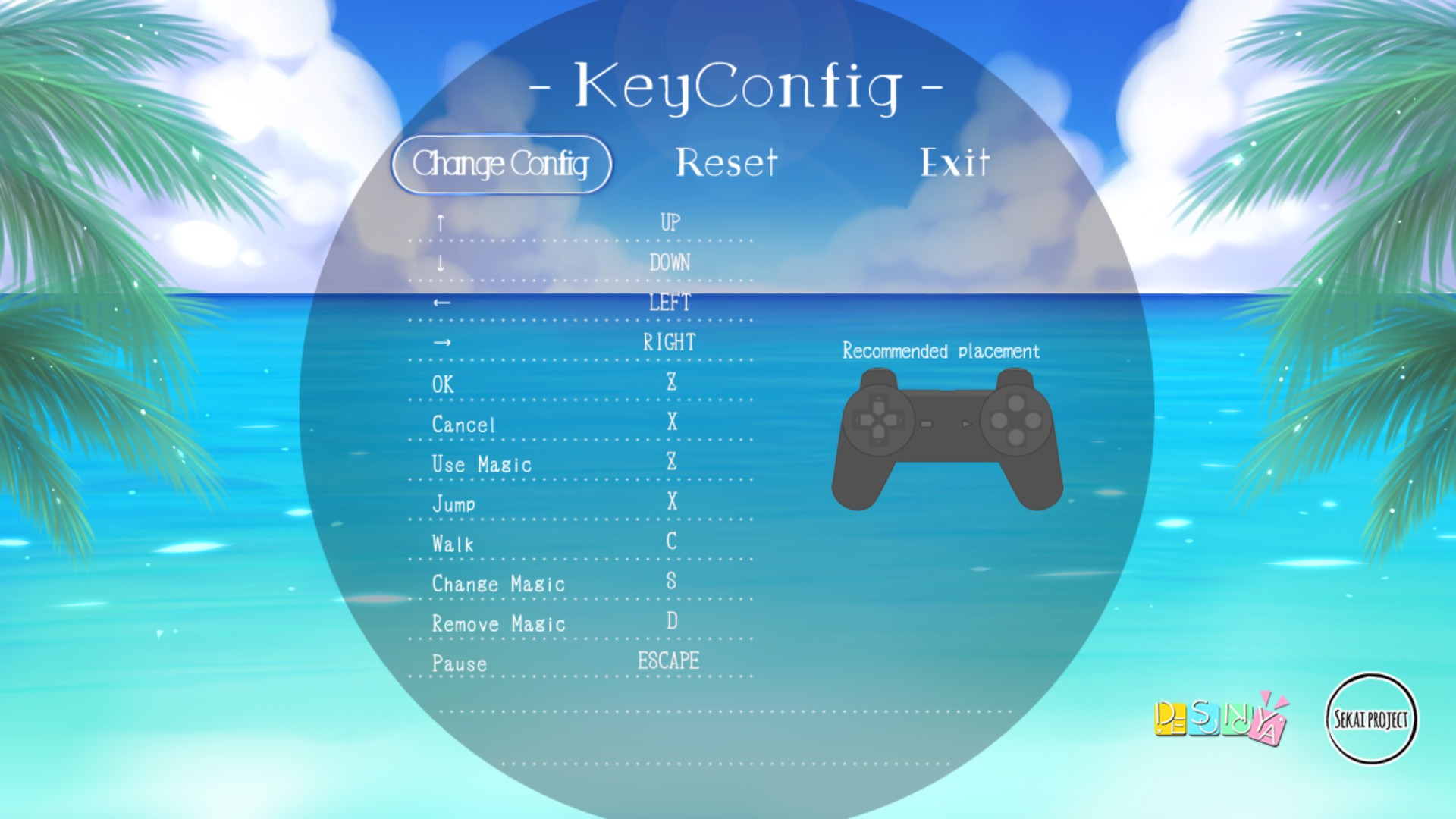
As much as this might be an oddball control scheme, fortunately, unlike a lot of western indie developers nowadays (I blame mobile for training a generation of developers to think “options” just means volume sliders), Japanese developers seem to recognize that all keys should be rebindable, so this isn’t much of a problem.
That said, this game is basically meant to be played with a controller, and I recommend you do if you have one. (I also recommend making the trigger buttons attack and jump, as you want dedicated fingers for the most important actions.)
Art Style
The artwork is very good for the kind of indie team that made Tobari 2. (There’s only two people listed as artists in the credits.)
That said, making a game directly comparing itself to Mario and Kirby leads me to compare it to those games, and I have to criticize Tobari for lacking the kind of aesthetic cohesiveness that Kirby games have, in particular. Kirby is a cutesy balloon with two arm flaps, booties, and a smiley face. His enemies are similar blobs of a different color. The whole world is equally colorful. Tobari has a clashing art style when you’re pitting a human against giant cartoony blob jellyfish, most mid-bosses are even more giant cartoony creatures, and then the boss fights are similarly small, detailed humanoids. Worse, the way they make the super-sized mid-bosses is just to take the same sprite and zoom in, leaving the creatures pixelated. It may be unfair to compare them to Nintendo, who are really the masters of coherent art design, but it’s something that I couldn’t avoid thinking about.
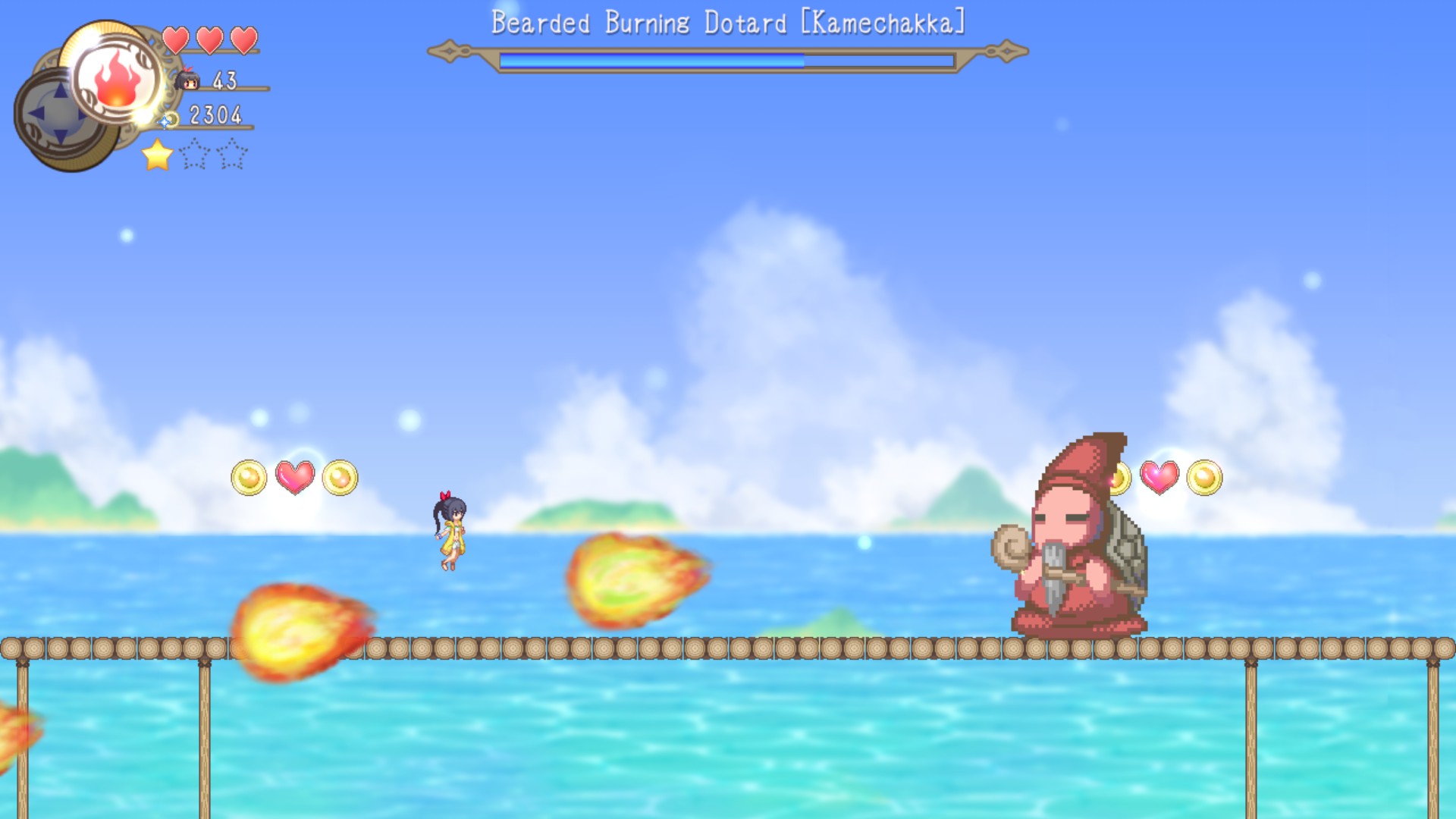
Sound
I wouldn’t buy the soundtrack separately, but this is one of the few games I don’t turn the sound off entirely, so the music is reasonably varied and good.
There are many voiced lines that are shouted out, but they’re all in Japanese. The lines Tobari’s friends shout are nonsense and don’t relate to what they are saying on the bottom of the screen, but what boss characters shout is worth listening to, as they telegraph what attack is coming your way. What’s most impressive is just that they have so many voiced lines at all. There’s only two programmers listed in the credits, but every named character has her own voice actress, and the quality is up to par with big name publishers.
That said, some of the attack spells (like Wind Cutter) are meant to be spammed, and Tobari cries “Hah!” with Every. Single. Attack. It gets… trying.
Verdict
Well, it’s mixing Mario and Kirby and very challenging in the last few levels. If that sounds like your sort of thing, it probably is. The game is a little on the short side (10-20 hours first playthrough to get 100%, depending on your skill) if you don’t go for the tears-of-blood levels of frustration challenge runs for the achievements or pure bragging rights. Still, at $12.99 base price, that’s perfectly reasonable.

